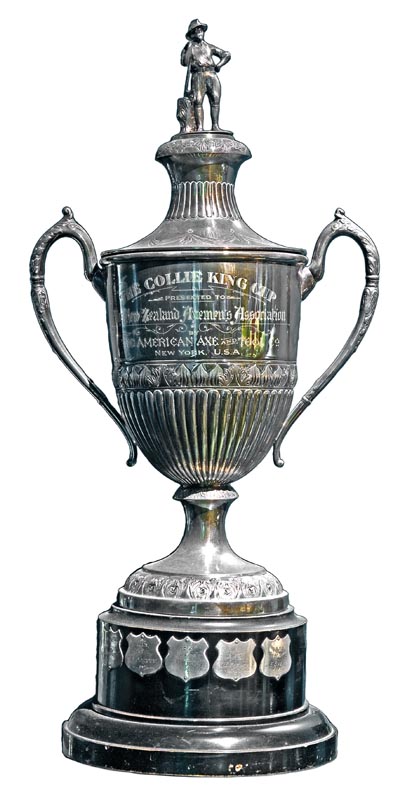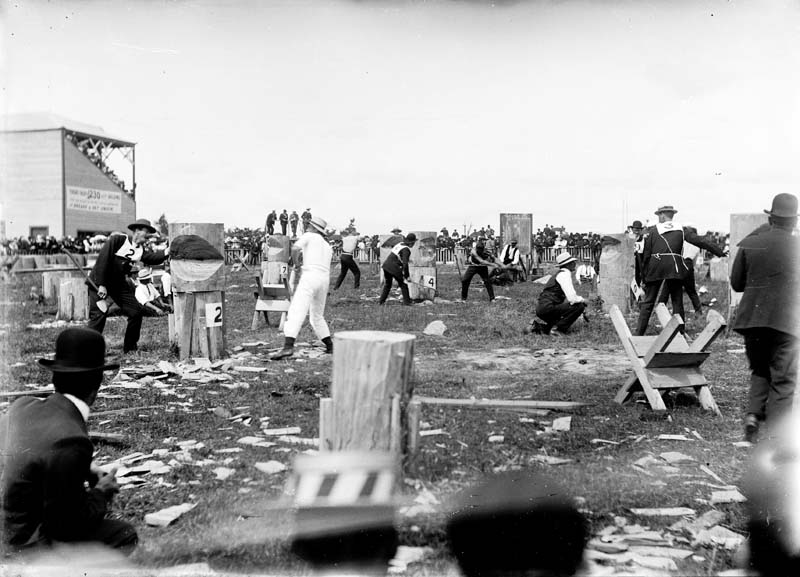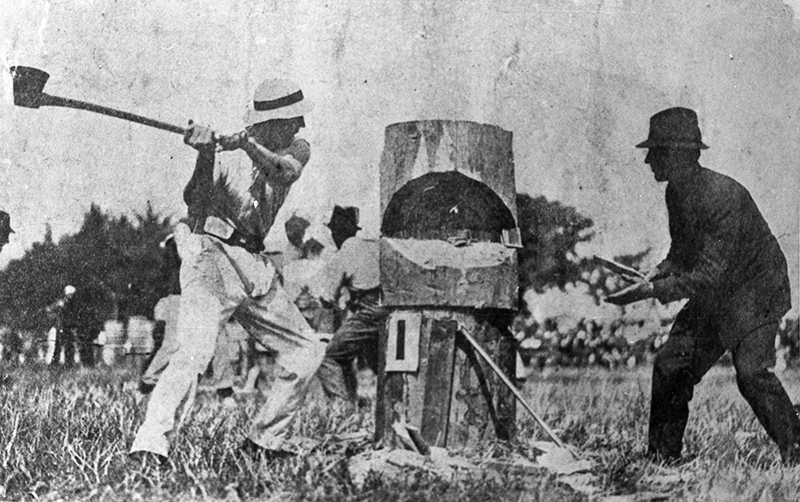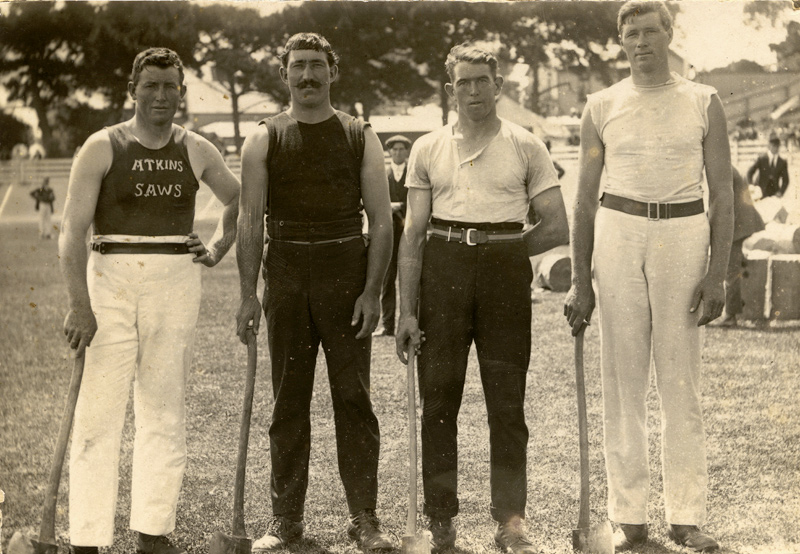




New Zealand was broken in by an axe and a cross cut saw - as a sport woodchopping is more traditional to the country than rugby. In a nation of woodchoppers Ned Shewry stood tall.
"Axemen stand by your blocks!" the cry rang out around the Eltham sports ground. A crowd gathered as a line of men stood, axe in hand before logs of peeled kahikatea. On block number two was a young man with rippling biceps, a shock of brown hair, wing nut ears, and a missing front tooth. Dressed in white, his trousers tucked into his socks and a pair of newly shined boots on his feet was local man Ned Shewry. On block three was Bill Peck, more than six feet tall and built like a kauri tree. The Australian was favourite to win the championship. Around the two were men from all over Australasia, tough men from the bush who took the art of chopping seriously.
Undaunted, the new chum from Tauhara made footholds so that his hobnail boots wouldn't slip, spat on his hands, grabbed his axe and then proceeded to beat the top axemen in the world. With a few swift cuts Ned Shewry had chopped his way to the top. Ned Shewry was to become a household name in New Zealand for nearly a quarter of a century.
Born in Stratford in 1889, John Edward (Ned) Shewry grew up on a backblocks farm at Tāhora. The district was just being broken in and Ned's parents Robert and Elizabeth had a large block of land on the Moki Road that was gradually being cleared for farmland.
The sliver of farm lay between the mighty Makino and Waitaanga forests - rugged, challenging country that rose steeply to the skyline in sharp ridges. The eleven Shewry children grew up with the ringing of axes, the warning yells of “timber!” and the thundering crash of falling trees thumping in their hearts.
Like many pioneer families struggling against the elements, tragedy struck the Shewry's - Ned's eldest sister Ada died in 1907 of epilepsy, and in 1914 a younger sister Dorothy died of burns after a can of petrol exploded near her.
When he was 17 Ned took up farming with his older brother Archie on a block next to their parents on the Moki Road. The young men set to work clearing the land with just a couple of axes, a saw and a packet of matches. Ned thrived on bushwhacking, he soon became adept with an axe and learnt the most economical way to fell a tree, the art of how to balance and get his hips behind the axe, like a golfer. He developed big calluses on his hands from handling the axe, and developed a fine physique.
"Ned was always strong," recalled his sister Rose Gallagher (nee Shewry) in an interview in 1984. "When Ned and Archie started work on the farm he wasn't much more than a boy so he developed chopping bush."
He soon caught the eye of Hughie McLeod, an old bushman who took him under his wing and entered the young man in the chopping events at the 1909 Whangamomona sports day. But Ned's first attempts at competition chopping were a disaster. He sailed into the log without getting properly balanced and finished well out of the prize money. His coach’ nearly walked away in disgust. After a good talking to, Ned came back to place second in the next heat - an 18 inch (45 centimetre) chop.
He came back the next year and chopped his way to success. The young man was thought so little of by the handicapper that he placed him on the limit - starting without a handicap - it was one of the last times that was to happen.
Years later, the story goes, when Ned had a handicap of 15 seconds in an 18 inch (45 centimetre) chop, a little old lady complained at his unsporting-like tactics. "It's not fair the way that fellow Shewry chops" she said. "He waits until the others have been chopping for seconds and seconds, and are tired, and then he starts! No wonder he wins; they're always too tired to keep up with him!"
After his win at Eltham the “Mecca of axemen” in 1911, there was no stopping Ned. He sent the chips flying as he won at chopping events around Taranaki and the King Country. In 1912 he headed to Auckland to compete against the big guns - world champion Dave Pretty, and Australian greats Bill Peck and Charlie Miley. He beat them all.
Now a big name in his own right Ned returned to Eltham where he won the 12 inch (30 centimetre) chop. Australia beckoned so the young man sailed overseas and competed in Brisbane, Toowoomba, Rockhampton and MacKay, building a reputation as a modest champion who let his action in the ring do the talking.
Back home Ned won again at Eltham - this time the world championship - taking away the 24 inch championship, the visitors' trophy for the 15 inch standing chop and the 12 inch underhand chop.
Just as Ned's chopping career looked set fate stepped in and ground it to a halt. His dreams of continuing the competition circuit were blunted. World War One drew New Zealand's young men away, Ned and his brother David included. In 1915 the pair sailed overseas on the SS Maunganui where Ned, and eventually his brother, served in the New Zealand Cycling Corps. Ned served in Egypt, France and Belgium.
Tragically David died from injuries received in France in 1917. Ned was wounded twice and awarded the Military Medal for bravery - saving an officers life while under fire. He himself was lucky to survive the war when he was buried alive - only the quick actions of his friends saved him from suffocation.
Ned didn't totally abandon his axe. He joked that he only received the Military Medal “because I kept the cookhouse supplied with kindling wood!” But his skills with an axe came to the attention of some top axemen serving with the Canadian, Australian, British and American forces. A sawmill had been established at La Matee Wood to provide timber for trenches and dugouts.
"Somebody told them that they had the New Zealand champion chopper there and you'd better sharpen up your axes because you won't have any chance with him" recalled his sister Rose. "They didn't believe it… They thought nobody from New Zealand was going to show them how to chop. When it came to chopping day they did get beaten!"
Ned Shewry's prowess as a chopper made it into international newspapers and was talked of “till the boys went home”.
Back home in New Zealand Ned picked up his axe and began competing like he'd never been away. In 1921 he again won the world championship 24 inch (45 centimetre) chop - this time in Gisborne. Proving he'd not lost his chopping prowess, Ned also obliterated the Australasian record for the 12 inch (30 centimetre) kahikatia chop, winning in a time of 25 seconds - 8.4 seconds faster than the record set by Dave Pretty in 1908. Having won the world championship for the second time Ned got to take the cup home.
After that Ned travelled around New Zealand demonstrating his skills as an axeman at fairs and carnivals. In 1925 he won the Australasian title at the Dunedin Exhibition, the right and left handed chop at North Auckland the 18 inch (45 centimetre) at Hamilton and the 18 inch underhand at Taihape.
In Legends in Their Lifetime Wallie Ingram writes: "It was a delight for old axemen to study a block after Shewry had cut it…'It was almost impossible to count the number of stroke he had made,' one of them told me.'Ned's cutting was as smooth as a baby's chin.'"
Often at chopping competitions a little betting would go on. Ned usually walked away on top. At Urenui Ned was challenged by a young man Whata Green, at that time unbeaten. Whata would go on to win the world championship, but that day in Ureuni he had to be content with coming last. Ned walked away with £50.
In 1934, after winning the Taranaki championship, Ned finally decided to put away his axe and finish with competition chopping. He was 45 and had been competitively chopping for over 20 years. He retired to a farm at Opunake, then bought a little farm on Corbett Road at Bell Block. In 1960 he gifted his competition axes and cups to the Taranaki Museum (now Puke Ariki).
But Ned wasn't just about chopping. Ironically the man who was a world champion in wood chopping, loved trees. "Ned was like Dad" recalled his sister Rose. "They both loved flowers and trees." Ned professed to despise ‘pansy growing’ as he called it - preferring mighty trees - but his garden in Bell Block - filled with lilies, bulbs and shrubs revealed this was not entirely true.
In later life Ned became involved with the gardens at Pukeiti and was a keen supporter of the Rhododendron Trust. He worked in the gardens at Pukeiti too, weeding and planting and helping design the layout of the reserve. He was described as a tireless collector of rare and good plants as well as an “indefatigable propagator”.
"Right up until a week or two before he died Ned was working at Pukeiti" said his sister. Ned Shewry died aged 73 on August 1, 1962. He is buried in the cemetery of St. Marks Church in Lepperton.
An obituary by his friend Rob Hair summed up the man: "Ned Shewry, world champion axeman, footballer, bush feller, farmer, plant lover a hard headed businessman, frugal in affairs of his own, generous with those he liked; keen brained, a hard hitter in debate, and the wielder of a sly and devastating wit."
In his will Ned bequeathed to Pukeiti bulbs, lilies, shrubs and trees from his garden along with £1200 toward his pet project - the Summit Road. He left the whole of his residuary estate to the Pukeiti Rhododendron Trust - with the proviso that “if it could survive for more than 20 years it deserved to have the land.”
In 1985 the money from Ned's estate was used to help build a gatehouse at Pukeiti and further expansion of the gardens. After years of chopping things down Ned Shewry had helped build a little oasis for future generations.
Ingram, W.F (1962). Legends in Their Lifetime. Wellington: A H Reed.
Beckett, R. (1983). Axemen stand by your logs! Sydney: Landsowne Press.
Puke Ariki Heritage Collection: New Shewry
LinkPlease do not reproduce these images without permission from Puke Ariki.
Contact us for more information or you can order images online here.